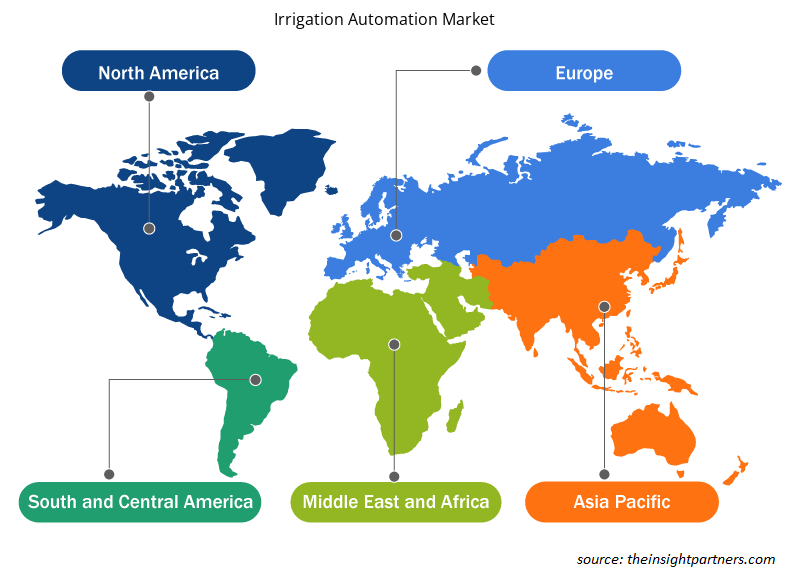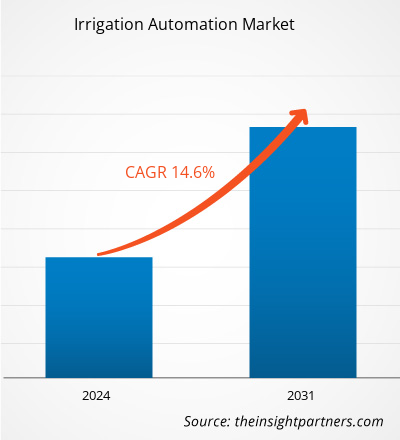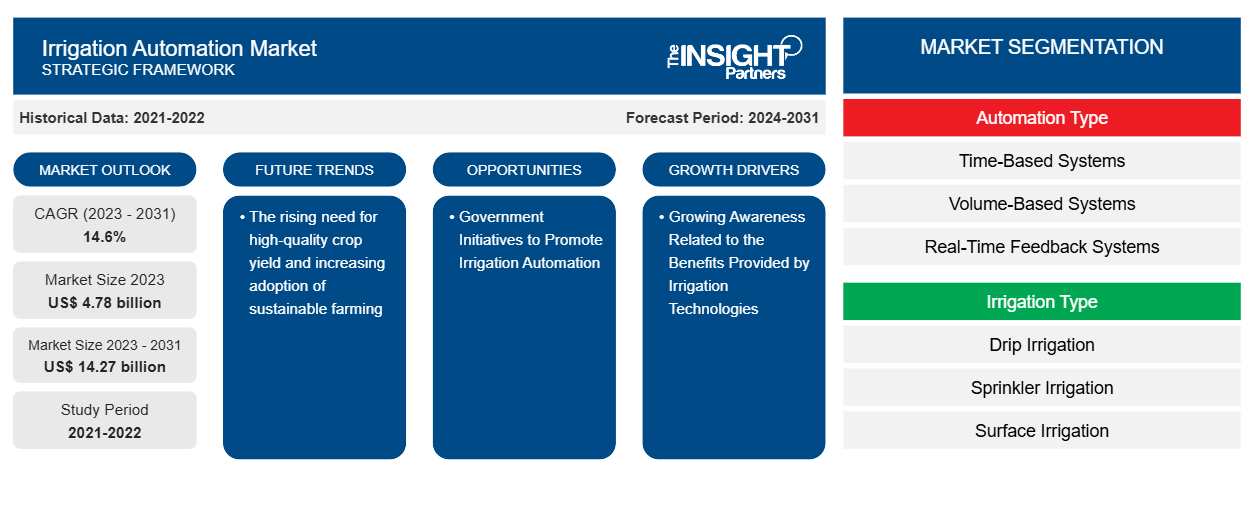Der Markt für Bewässerungsautomatisierung soll von 4,78 Milliarden US-Dollar im Jahr 2023 auf 14,27 Milliarden US-Dollar im Jahr 2031 anwachsen. Der Markt wird voraussichtlich zwischen 2023 und 2031 eine durchschnittliche jährliche Wachstumsrate von 14,6 % verzeichnen. Der steigende Bedarf an hochwertigen Ernteerträgen und die zunehmende Einführung nachhaltiger Landwirtschaft dürften weiterhin ein wichtiger Trend auf dem Markt für Bewässerungsautomatisierung bleiben.
Marktanalyse für Bewässerungsautomatisierung
Der Markt für Bewässerungsautomatisierung wächst rasant, da das Bewusstsein für die Vorteile von Bewässerungstechnologien wächst und präzise landwirtschaftliche Instrumente und Techniken akzeptiert werden. Der Markt wächst stetig, angetrieben von der steigenden Nachfrage nach intelligenten Agrartechnologien. Darüber hinaus bieten technologische Fortschritte und staatliche Initiativen zur Förderung der Bewässerungsautomatisierung lukrative Möglichkeiten für Marktwachstum.
Marktübersicht zur Bewässerungsautomatisierung
Bei der Bewässerungsautomatisierung werden Instrumente oder Geräte verwendet, um verschiedene Bewässerungssysteme zu betreiben und den Wasserfluss aus Buchten zu verändern. Die Bewässerungsautomatisierung umfasst die Kombination zahlreicher Hardware wie Sensoren, Ventile, Steuerungen, Sprinkler und mehr, um ein automatisiertes System aufzubauen, das sowohl für landwirtschaftliche als auch für nicht-landwirtschaftliche Anwendungen verwendet werden kann. Wesentliche Vorteile der Bewässerungsautomatisierung, wie Zeitersparnis, Kosteneffizienz, Ressourcenoptimierung und andere, treiben den Markt an.
Passen Sie diesen Bericht Ihren Anforderungen an
Sie erhalten kostenlose Anpassungen an jedem Bericht, einschließlich Teilen dieses Berichts oder einer Analyse auf Länderebene, eines Excel-Datenpakets sowie tolle Angebote und Rabatte für Start-ups und Universitäten.
-
Holen Sie sich die wichtigsten Markttrends aus diesem Bericht.Dieses KOSTENLOSE Beispiel umfasst eine Datenanalyse von Markttrends bis hin zu Schätzungen und Prognosen.
Markttreiber und Chancen für die Bewässerungsautomatisierung
Wachsendes Bewusstsein für die Vorteile von Bewässerungstechnologien treibt den Markt an
Landwirte werden sich der automatisierten Bewässerungstechnologien, die mit hohen Arbeits- und Stromkosten verbunden sind, immer bewusster. Bewässerungstechnologien bieten den Anwendern erhebliche Vorteile, wie Wassereinsparung, Prozessautomatisierung und Kosteneinsparungen, die den Markt antreiben. Diese Vorteile erhöhen das Bewusstsein der Landwirte, was die Einführung von Bewässerungstechnologien vorantreibt. Diese Technologien unterstützen Landwirte dabei, ihren täglichen Stromverbrauch zu senken und den Zeit- und Arbeitsaufwand für die Bewässerung zu reduzieren. Darüber hinaus konnten Landwirte durch die Automatisierung die Anzahl der Fahrten zum Hof reduzieren, was zu geringeren Arbeitskosten führte. Die Installation eines automatisierten Bewässerungssystems verbessert die landwirtschaftliche Präzision, indem die genaue Wassermenge und die Bewässerungszeit bestimmt werden. Diese Präzision reduziert Ernteverluste für Landwirte und steigert die Gesamtproduktivität.
Regierungsinitiativen zur Förderung der Bewässerungsautomatisierung – eine Chance auf dem Markt für Bewässerungsautomatisierung
Die Mehrheit der Landwirte in unterentwickelten Ländern verwendet konventionelle Bewässerungssysteme (Oberflächenbewässerung), was ein zeitaufwändiger Prozess ist. Dies ermutigt die Regierungen verschiedener Länder, positive Initiativen zur Förderung der Bewässerungsautomatisierung zu ergreifen, was voraussichtlich Chancen auf dem Markt schaffen wird. Viele Regierungen in Entwicklungsländern wie Indien, China, Brasilien, den USA, Frankreich und anderen afrikanischen Ländern bieten Zuschüsse für den Kauf von Tropf- und Sprinklersystemen an, um die Effizienz ihrer Bewässerungssysteme zu steigern. Darüber hinaus helfen strenge Richtlinien, die den Einsatz von Sprinkler- und Tropfbewässerungssystemen fördern, den Landwirten, technologisch entwickelte Systeme auf ihren Farmen einzuführen, wie z. B. den Erwerb und die Neuinstallation von landwirtschaftlichen Bewässerungsgeräten ( Sprinkler- und Tropfbewässerungssysteme). Diese Faktoren schaffen im Prognosezeitraum erhebliche Wachstumschancen für den Markt.
Segmentierungsanalyse des Marktberichts zur Bewässerungsautomatisierung
Wichtige Segmente, die zur Ableitung der Marktanalyse zur Bewässerungsautomatisierung beigetragen haben, sind Automatisierungstyp, Bewässerungstyp, Komponente, System und Endbenutzer.
- Basierend auf der Art der Automatisierung ist der Markt in zeitbasierte Systeme, volumenbasierte Systeme, Echtzeit-Feedbacksysteme und computergestützte Bewässerungssteuerungssysteme unterteilt. Das Segment der zeitbasierten Systeme hatte im Jahr 2023 einen größeren Marktanteil.
- Auf der Grundlage der Bewässerungsart ist der Markt in Tropfbewässerung, Sprinklerbewässerung und Oberflächenbewässerung unterteilt. Das Segment der Tropfbewässerung hatte im Jahr 2023 einen größeren Marktanteil.
- In Bezug auf die Komponenten ist der Markt in Steuerungen, Sensoren, Ventile, Sprinkler und andere unterteilt. Das Segment der Steuerungen hatte im Jahr 2023 einen größeren Marktanteil.
- Basierend auf dem System ist der Markt für Bewässerungsautomatisierung in automatisch und halbautomatisch unterteilt. Das automatische Segment hatte im Jahr 2023 einen größeren Marktanteil.
- In Bezug auf die Endverwendung wird der Markt in landwirtschaftlich und nicht-landwirtschaftlich unterteilt. Das Agrarsegment hatte im Jahr 2023 einen größeren Marktanteil.
Marktanteilsanalyse für Bewässerungsautomatisierung nach Geografie
Der geografische Umfang des Marktberichts zur Bewässerungsautomatisierung ist hauptsächlich in fünf Regionen unterteilt: Nordamerika, Asien-Pazifik, Europa, Naher Osten und Afrika sowie Südamerika/Süd- und Mittelamerika.
In Bezug auf den Umsatz hatte der asiatisch-pazifische Raum aufgrund der großen landwirtschaftlichen Flächen und der günstigen staatlichen Unterstützung den größten Marktanteil im Bereich der Bewässerungsautomatisierung. Es wird erwartet, dass der Markt in naher Zukunft expandieren wird, was auf die raschen Veränderungen der Klimabedingungen und die wachsende Notwendigkeit zur Reduzierung der Abfallverschwendung zurückzuführen ist. Darüber hinaus kurbeln technologische Fortschritte und die Entwicklung fortschrittlicher Bewässerungssysteme den Markt im Prognosezeitraum an.
Regionale Einblicke in den Markt für Bewässerungsautomatisierung
Die regionalen Trends und Faktoren, die den Markt für Bewässerungsautomatisierung im Prognosezeitraum beeinflussen, wurden von den Analysten von Insight Partners ausführlich erläutert. In diesem Abschnitt werden auch die Marktsegmente und die Geografie der Bewässerungsautomatisierung in Nordamerika, Europa, im asiatisch-pazifischen Raum, im Nahen Osten und Afrika sowie in Süd- und Mittelamerika erörtert.

- Erhalten Sie regionale Daten zum Markt für Bewässerungsautomatisierung
Umfang des Marktberichts zur Bewässerungsautomatisierung
| Berichtsattribut | Details |
|---|---|
| Marktgröße im Jahr 2023 | 4,78 Milliarden US-Dollar |
| Marktgröße bis 2031 | 14,27 Milliarden US-Dollar |
| Globale CAGR (2023 - 2031) | 14,6 % |
| Historische Daten | 2021-2022 |
| Prognosezeitraum | 2024–2031 |
| Abgedeckte Segmente |
Nach Automatisierungstyp
|
| Abgedeckte Regionen und Länder |
Nordamerika
|
| Marktführer und wichtige Unternehmensprofile |
|
Marktteilnehmerdichte: Der Einfluss auf die Geschäftsdynamik
Der Markt für Bewässerungsautomatisierung wächst rasant, angetrieben durch die steigende Nachfrage der Endnutzer aufgrund von Faktoren wie sich entwickelnden Verbraucherpräferenzen, technologischen Fortschritten und einem größeren Bewusstsein für die Vorteile des Produkts. Mit steigender Nachfrage erweitern Unternehmen ihr Angebot, entwickeln Innovationen, um die Bedürfnisse der Verbraucher zu erfüllen, und nutzen neue Trends, was das Marktwachstum weiter ankurbelt.
Die Marktteilnehmerdichte bezieht sich auf die Verteilung der Firmen oder Unternehmen, die in einem bestimmten Markt oder einer bestimmten Branche tätig sind. Sie gibt an, wie viele Wettbewerber (Marktteilnehmer) in einem bestimmten Marktraum im Verhältnis zu seiner Größe oder seinem gesamten Marktwert präsent sind.
Die wichtigsten auf dem Markt für Bewässerungsautomatisierung tätigen Unternehmen sind:
- Galcon GmbH
- Hunter Industries Inc.
- Irritec SpA
- Jain Irrigation Systems Ltd.
- Lindsay Corporation
- Nelson Irrigation Corporation
Haftungsausschluss : Die oben aufgeführten Unternehmen sind nicht in einer bestimmten Reihenfolge aufgeführt.

- Überblick über die wichtigsten Akteure auf dem Markt für Bewässerungsautomatisierung
Neuigkeiten und aktuelle Entwicklungen zum Markt für Bewässerungsautomatisierung
Der Markt für Bewässerungsautomatisierung wird durch die Erhebung qualitativer und quantitativer Daten nach Primär- und Sekundärforschung bewertet, die wichtige Unternehmensveröffentlichungen, Verbandsdaten und Datenbanken umfasst. Im Folgenden finden Sie eine Liste der Entwicklungen auf dem Markt für Bewässerungsautomatisierung und -strategien:
- Im März 2024 teilt Rubicon Water sein neuestes Projekt an der Grenze zwischen Usbekistan und Tadschikistan. Dieses innovative Projekt, das vom Schweizer Kooperationsbüro und der Blue Peace Initiative unterstützt wird, konzentriert sich auf die grenzüberschreitende Verteilung und Messung, um die Zusammenarbeit im grenzüberschreitenden Wassermanagement zu fördern. Neben der Verbesserung des Wassermanagements für die Bewässerung spielt die Technologie von Rubicon eine zunehmend entscheidende Rolle im Grundwassermanagement, bei Aufladeprogrammen und Umweltflussinitiativen und trägt zur Erhaltung lebenswichtiger Wasserressourcen und Ökosysteme bei. (Quelle: Rubicon Water, Pressemitteilung, 2024)
Marktbericht zur Bewässerungsautomatisierung – Umfang und Ergebnisse
Der Bericht „Marktgröße und Prognose für Bewässerungsautomatisierung (2021–2031)“ bietet eine detaillierte Analyse des Marktes, die die folgenden Bereiche abdeckt:
- Marktgröße und Prognose auf globaler, regionaler und Länderebene für alle wichtigen Marktsegmente, die im Rahmen des Projekts abgedeckt sind
- Marktdynamik wie Treiber, Beschränkungen und wichtige Chancen
- Wichtige Zukunftstrends
- Detaillierte PEST/Porters Five Forces- und SWOT-Analyse
- Globale und regionale Marktanalyse mit wichtigen Markttrends, wichtigen Akteuren, Vorschriften und aktuellen Marktentwicklungen
- Branchenlandschaft und Wettbewerbsanalyse, einschließlich Marktkonzentration, Heatmap-Analyse, prominenten Akteuren und aktuellen Entwicklungen
- Detaillierte Firmenprofile
- Historische Analyse (2 Jahre), Basisjahr, Prognose (7 Jahre) mit CAGR
- PEST- und SWOT-Analyse
- Marktgröße Wert/Volumen – Global, Regional, Land
- Branchen- und Wettbewerbslandschaft
- Excel-Datensatz
Aktuelle Berichte
Erfahrungsberichte
Grund zum Kauf
- Fundierte Entscheidungsfindung
- Marktdynamik verstehen
- Wettbewerbsanalyse
- Kundeneinblicke
- Marktprognosen
- Risikominimierung
- Strategische Planung
- Investitionsbegründung
- Identifizierung neuer Märkte
- Verbesserung von Marketingstrategien
- Steigerung der Betriebseffizienz
- Anpassung an regulatorische Trends























 Kostenlose Probe anfordern für - Markt für Bewässerungsautomatisierung
Kostenlose Probe anfordern für - Markt für Bewässerungsautomatisierung